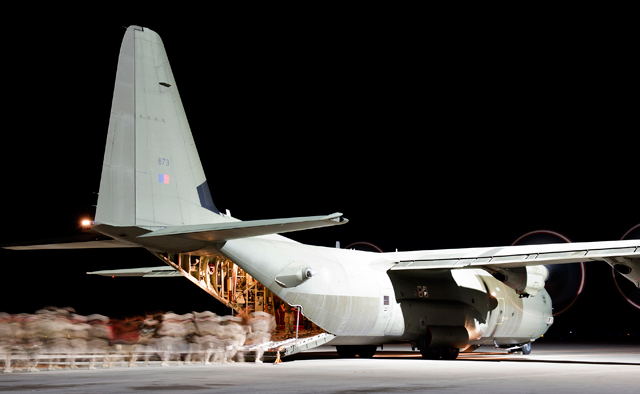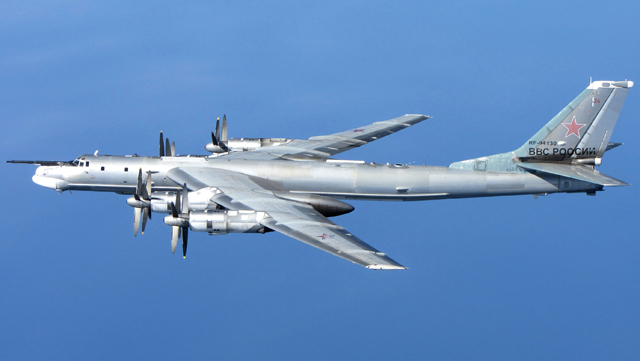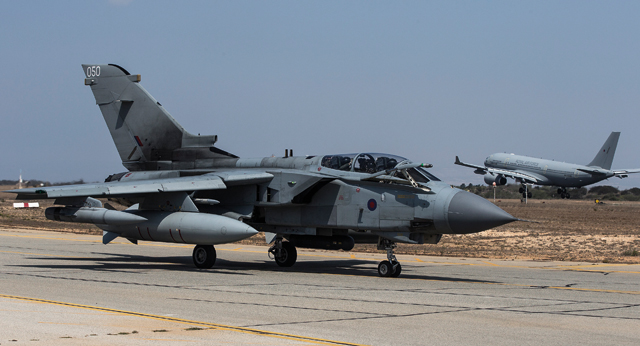European defence forces are facing a “perfect storm”, and those in the UK are at its eye. So says Andrew Dorman, professor of international security in the Defence Studies Department at King’s College London and a lecturer at the UK Joint Services Command and Staff College in Shrivenham.
The forces energising the storm are many, Dorman says, but he sums up the challenge as “ambiguous warfare in an age of austerity”. The “ambiguous” tag refers to the enemy not always being easy to identify; it may be a group rather than a nation and in a state of flux rather than being a recognisable entity. Since 2010, when the UK’s last Strategic Defence and Security Review (SDSR) was carried out, the world has changed dramatically, he points out, and plans for the UK’s defence and for projecting its influence envisaged then look hopelessly inappropriate now. Finally, budget austerity completes the storm’s destructive power.
Dorman’s comments were made at a conference of the UK Royal Air Force Air Combat Support Group. At this annual event, the group’s air officer commanding, Air Vice-Marshal Sean Reynolds, gathers his force leaders and senior officers at RAF Northolt, London, for a day to ponder the challenges they are likely to face, and to share experiences and views. Dorman’s task was to present his view of the macroeconomic state of affairs as it affects the military generally, plus a specialist academic’s view of the global threat landscape.

British troops are leaving Afghanistan, but not trouble, behind
Crown Copyright
The RAF’s Air Combat Support Group has recently been through a testing time, with its resources fully stretched to meet government commitments. Its transport capabilities have just been engaged in bringing British forces and their equipment back from the long conflict in Afghanistan. The operation has gone without a hitch despite other demands on the group which, since September 2013, has gone through the process of retiring three types – the Lockheed Martin C-130K, Vickers VC10 and Lockheed TriStar – and putting into operation the Airbus A330 Voyager tanker/transport. It is, at present, engaged in training and organising for the introduction of the Airbus A400M tactical transport.
Also in the last few months, Whitehall called at short notice for the RAF to join the US Air Force in mounting strikes against Islamic State (IS) forces in northern Iraq and providing humanitarian relief to groups under attack. That entailed deploying strike and Combat Support Group elements to operate out of RAF Akrotiri in Cyprus, using C-130Js to drop supplies to beleaguered locals attacked by IS forces, and ensuring that the A330 Voyager got its first real conflict “outing” to refuel initially a pair of Panavia Tornado GR4s on a series of reconnaissance and then strike missions.
Dorman put to the gathering the proposition that at the time of the last SDSR in 2010, nobody would have predicted that a Tunisian people’s revolt – in December of that year – would have toppled the government, launching what became known as the Arab Spring. Emphasising the unpredictability of today’s emerging threats, he listed a series of events that amount to a roll-call of turmoil. These covered the sheer extent of Syria’s internal strife and its destabilising effect on the whole Middle East; the rise of the well-funded, highly militant self-proclaimed Islamic State in Iraq and Syria; the Western intervention in Libya and the internal instability it has unleashed; Egypt’s overthrow of the established military regime, then its reversion to the military when democracy didn’t work as envisaged. Also mentioned were Ukraine’s move to replace a corrupt but pro-Russian government and Moscow’s reaction: annexing Crimea and supporting rebellion in eastern Ukraine. Finally, tying into that, is the imposition of Western economic sanctions against Russia in protest at its Ukraine action, which has provoked President Vladimir Putin to flex his military muscle in a style reminiscent of the Cold War.

Russia has used Tupolev Tu-95s to flex its muscles
Crown Copyright
Just the previous week, there had been eight incidents of Russian Tupolev Tu-95 long-range bombers provoking RAF Eurofighter Typhoon interceptions over the North Sea: a somewhat higher than normal rate clearly intended by Putin to impart a message.
Add to these gathering threats a rise in cyber-attack probes, says Dorman, not just on military assets but on infrastructure services and utilities. These are the types of threats faced by Western militaries now, and the question that the RAF leaders were at Northolt to ponder was what part the UK could play in containing them, and with what tools.
Next year there will be another SDSR, and Chatham House, the London-based Royal Institute of International Affairs, has this to say about it: “With unfinished business from its 2010 predecessor, and with no sign that UK national strategy is about to escape the grip of austerity, the 2015 SDSR is set to be more complex and contentious than the government might have hoped. There is a possibility that the review will, yet again, see the three armed services struggle against each other to secure the largest slice of a diminishing cake.”
It is not as if the UK government is unaware of these changes. In July, it launched a review of existing Future Force 2020 plans, acknowledging that things had changed. It referred to “the impact on the plans for FF 2020 of the challenging global political and security context, including in Ukraine, the Middle East and Africa; the changing size, structures and priorities of other international forces including those of the UK’s usual allies; and decisions on Scottish independence.”
The Scottish independence issue, it is generally agreed, is a genie that cannot be stuffed back into the bottle just because it was rejected in a September referendum. The biggest single factor in UK defence strategy that is clouded by the possibility of Scottish independence is the nation’s submarine-based Trident nuclear deterrent. This is based at Faslane in Scotland, and the Scottish National Party declares it wants none of it following its planned achievement of independence. Yet, Dorman remarks, quoting former Prime Minister Tony Blair, however cash-strapped the UK government is, no prime minister wants to be the one who drops Britain’s nuclear deterrent.
Money is, indeed, the problem – and it will remain so. Dorman characterises the UK’s cautiously acknowledged economic upturn as “a tax-free recovery”, because so many individuals and small businesses are living on the margins of economic viability, even if they remain in work or solvency. He also talks of “a post-heroic population”, which appreciates what its servicemen do but does not want to pay for it. The 2015 defence review will be more brutal than the last, Dorman argues, because financial austerity is still warranted, health and education budgets are ring-fenced, and so defence will inevitably be hit again.
Meanwhile, Dorman’s judgements about the existing FF 2020 in the present context are scathing, calling its defined force structure “an unaffordable, land-centric, top-heavy military designed to fail”. Personnel cuts at the last review were at the front line, with hardly any reductions at the one-star level and above, he notes. The Royal Navy, he believes, needs more destroyers and frigates but is getting two aircraft carriers which may end up with insufficient numbers of embarked aircraft, and it has amphibious forces when the need for the latter is getting increasingly difficult to justify. It is clear that Dorman would be surprised if the UK gets the promised numbers of Lockheed F-35B combat aircraft after the 2015 SDSR.
The revised FF 2020 plan depends heavily on cutting the regular forces and topping up their capability with larger reserves. While not dismissing the concept, Dorman suggests alternative approaches might be considered, especially where the British Army is concerned. With energetic recruiting at a time of need, he says, the army could theoretically train “a new battalion every 14 weeks”. He observes that perhaps a standing force of 80,000 is unnecessary and 50,000 might do. To put that in context, before the last SDSR, the army’s strength was more than 100,000. Increased equipment mothballing might also provide a lower-cost way to upscale when necessary, providing instant reaction is not required. Pooling capability with allies is already under examination but may become more general.
Looking at the future operating environment, a senior officer from Shrivenham observes that the global tendency for population drift from rural areas into cities, particularly mega-cities, changes the whole nature of effective warfare, making a large conventional army less relevant and heightening the importance of precision air strikes and special-forces deployment. The need for a strike element is the one RAF capability that is not questioned in any of the defence reviews, but if special-forces deployment and humanitarian aid and disaster-relief work rise in importance, the Combat Support Group’s new transports and its Boeing CH-47 Chinook force will be increasingly called upon to deliver.
In line with the Chatham House prediction that inter-service rivalry will heighten ahead of further cuts, Dorman describes the army’s force of retired generals as “already mobilised and rabid” and engaged in lobbying via the media against further reductions in standing manpower.
The age of austerity means new solutions have to be found. Dorman observes that, at present, “there is no incentive for departments not to spend their entire budget”. Could military leaders, he asks, be given the choice of where to make economies and efficiencies in their complete force, rather than “use or lose” departmental budgets? The government has to find ways to incentivise on-the-hoof cost-saving by the military, rather than simply imposing budgets.

Tornado GR4s are now being flown over Iraq with Voyager tanker support
Crown Copyright
A study of the joint service Military Aviation Authority’s (MAA) most recent published report reveals that the MAA warns of the risk to safe air operations of cuts made without thought for their secondary effects. Following the 2006 fatal loss of a BAE Systems Nimrod MR2 over Afghanistan because of design faults and engineering complacency, a review by barrister Charles Haddon-Cave of the culture that led to the accident was scathing about the attitude of passivity engendered in the military by having continually to adjust to changing objectives. The MAA was created to rectify this by providing a broader oversight of capability. Now the MAA faces cuts and in its 2012-2013 report warns: “Further reductions [at the MAA] could re-create the conditions of which the Haddon-Cave report was so critical.” The single most repeated lament in the report is a shortage, across the board, of “suitably qualified and experienced personnel”. Those cannot be conjured up at short notice.
Airbus Defence & Space sent a representative to Northolt for the conference. Retired Grp Capt Tony Toner emphasised the manufacturer’s support for the RAF’s Voyager and A400M fleets but stated frankly that in the future manufacturers of all types, and service providers, will be more careful about the nature of the military contracts they sign now that the Western military market is shrinking.
“There is only one thing worse than a shrinking customer base, and that is a shrinking customer base with shrinking budgets,” Toner says.
Source: Flight International



















